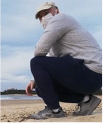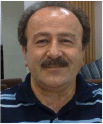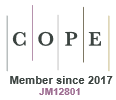Occurrence of Nocardia in near shore marine environments and its public and environmental implications
Luke Wright A , Mohammad Katouli A and İpek Kurtböke A *A

Dr Luke Wright graduated from the University of the Sunshine Coast, where he earned a BSc, Honours, and a PhD under the supervisions of Assoc. Prof. İpek Kurtböke and Assoc. Prof. Mohammad Katouli investigating the occurrence of Nocardia species in near shore marine environments of the Sunshine Coast Region. His study revealed the presence of novel Nocardia species in the foaming waters, and he described two new species in a collaborative investigation with the DSMZ in Germany. Dr Wright’s study increased awareness in the region and contributed toward international studies related to mapping of nocardiae in four corners of the world. |

Assoc. Prof. Mohammad Katouli is a member of the Centre for Bioinnovation (CBI) and the School of Science, Technology and Engineering at the University of the Sunshine Coast. He has been working for many years on pathogenic mechanisms of bacteria isolated from clinical and environmental sources. His current focus is on how probiotic strains can mitigate the pathogenicity of translocating (TEC) and adherent and invasive Escherichia coli (AIEC) strains in intestinal epithelial and modulates host cell gene expression. Since 1998, he has been a member of the ASM and the chair of the Queensland branch committee between 2014 and 2016. |

Assoc. Prof. İpek Kurtböke has been working in the field of biodiscovery and has been an active member of the international actinomycete research community since 1982. She currently conducts research and teaches in the field of applied microbiology and biotechnology at the University of the Sunshine Coast, Queensland. She has also been an active member of the World Federation of Culture Collections (WFCC) and currently is the President of the Federation. She was also an Editorial Board member of Microbiology Australia for 20 years (2004–2024). |
Abstract
Since 2003, large foaming events resembling ‘chocolate mousse-like foam’ have been reported along several popular beaches on the Sunshine Coast, Queensland, Australia, following storms and turbulent sea water events. Earlier studies at the University of the Sunshine Coast (UniSC) first highlighted that these foaming events contained an abundance of filamentous actinomycete species, specifically from the genus Nocardia. Species of this genus are frequently detected in the foams of sewage treatment plants during the activated sludge process. Nocardiae can form an extensive mycelial network and trap fats, oil and grease, which exacerbates foam formation. In addition, Nocardia species are known to be pathogenic and cause various diseases including nocardiosis in human and animal hosts. This review focusses on the occurrence, diversity and virulence properties of Nocardia species with examples of isolations of Nocardiae from foaming coastal marine waters of the region.
 Dr Luke Wright graduated from the University of the Sunshine Coast, where he earned a BSc, Honours, and a PhD under the supervisions of Assoc. Prof. İpek Kurtböke and Assoc. Prof. Mohammad Katouli investigating the occurrence of Nocardia species in near shore marine environments of the Sunshine Coast Region. His study revealed the presence of novel Nocardia species in the foaming waters, and he described two new species in a collaborative investigation with the DSMZ in Germany. Dr Wright’s study increased awareness in the region and contributed toward international studies related to mapping of nocardiae in four corners of the world. |
 Assoc. Prof. Mohammad Katouli is a member of the Centre for Bioinnovation (CBI) and the School of Science, Technology and Engineering at the University of the Sunshine Coast. He has been working for many years on pathogenic mechanisms of bacteria isolated from clinical and environmental sources. His current focus is on how probiotic strains can mitigate the pathogenicity of translocating (TEC) and adherent and invasive Escherichia coli (AIEC) strains in intestinal epithelial and modulates host cell gene expression. Since 1998, he has been a member of the ASM and the chair of the Queensland branch committee between 2014 and 2016. |
 Assoc. Prof. İpek Kurtböke has been working in the field of biodiscovery and has been an active member of the international actinomycete research community since 1982. She currently conducts research and teaches in the field of applied microbiology and biotechnology at the University of the Sunshine Coast, Queensland. She has also been an active member of the World Federation of Culture Collections (WFCC) and currently is the President of the Federation. She was also an Editorial Board member of Microbiology Australia for 20 years (2004–2024). |
References
1 Nocard E (1888) Note sur la maladie des boeufs de la Gouadeloupe connue sous le nom de farcin. Ann Inst Pasteur (Paris) 2, 293-302 [In French].
| Google Scholar |
3 List of Prokaryotic names with Standing in Nomenclature (LPSN). Nocardia. Available at https://bacterio.net/genus/nocardia
4 Rawat V, Umesh U, Thapliyal N, Punera DC (2012) Primary pulmonary infection caused by 20% acid fast Nocardia brasiliensis. Indian J Med Microbiol 29, 446-447.
| Google Scholar |
6 Eppinger HL (1890) Über eine neue pathogene Cladothrix und eine durch sie hervorgerufene Pseudotuberkulosis (Cladothrichia). Beitr Pathol Anat Allg Pathol 9, 287-328 [In German].
| Google Scholar |
7 CDC. Nocardiosis—About Nocardiosis; 2024. https://www.cdc.gov/nocardiosis/about/index.html
8 MSD Veterinary Manual. Nocardiosis in animals; 2024. https://www.msdvetmanual.com/infectious-diseases/nocardiosis/nocardiosis-in-animals#Clinical-Findings_v3273859
9 Lee D-C, Cho M-Y, Park S-I (2007) A review of nocardial infection in fishes. J Fish Pathol 20, 1-23.
| Google Scholar |
11 Seo JP, Lee SD (2006) Nocardia harenae sp. nov., an actinomycete isolated from beach sand. Int J Syst Evol Microbiol 56, 2203-2207.
| Crossref | Google Scholar | PubMed |
12 Heard J, Harvey E, Johnson BB, Wells JD, Angove MJ (2008) The effect of filamentous bacteria on foam production and stability. Colloids Surf B Biointerfaces 63, 21-26.
| Crossref | Google Scholar | PubMed |
13 Jiang C, McIlroy SJ, Qi R, Petriglieri F, Yashiro E, Kondrotaite Z, Nielsen PH (2021) Identification of microorganisms responsible for foam formation in mesophilic anaerobic digesters treating surplus activated sludge. Water Res 191, 116779.
| Crossref | Google Scholar | PubMed |
14 Blackall LL, Harbers AE, Greenfield PF, Hayward AC (1991) Foaming in activated sludge plants: a survey in Queensland, Australia and an evaluation of some control strategies. Water Res 25, 313-317.
| Crossref | Google Scholar |
15 Mamais D, Kalaitzi E, Andreadakis A (2011) Foaming control in activated sludge treatment plants by coagulants addition. Glob Nest J 13, 237-245.
| Google Scholar |
16 Thomas JA, Soddell JA, Kurtböke Dİ (2002) Fighting foam with phages? Water Sci Technol 46, 511-518.
| Crossref | Google Scholar | PubMed |
17 Petrovski S, Seviour RJ, Tillett D (2011) Prevention of Gordonia and Nocardia stabilized foam formation by using bacteriophage GTE7. Appl Environ Microbiol 77, 7864-7867.
| Crossref | Google Scholar | PubMed |
18 Soddell JA, Seviour RJ (1995) Relationship between temperature and growth of organisms causing Nocardia foams in activated sludge plants. Water Res 29, 1555-1558.
| Crossref | Google Scholar |
19 Schoen L, Santoro JD, Milla C, Bhargava S (2015) Pulmonary nocardiosis in an immunocompetent patient with cystic fibrosis. Case Rep Pulmonol 2015, 984171.
| Crossref | Google Scholar | PubMed |
20 Das AK, Nandy S, Dudeja M, Tiwari R, Alam S (2013) The incidence of nocardiosis at pulmonary and extra–pulmonary sites. J Clin Diagn Res 7, 1427-1429.
| Crossref | Google Scholar | PubMed |
21 Zijlstra EE, van de Sande W, Welsh O, Mahgoub ES, Goodfellow M, Fahal AH (2016) Mycetoma: a unique neglected tropical disease. Lancet Infect Dis 16, 100-112.
| Crossref | Google Scholar | PubMed |
22 Ashiru OT, Pillay M, Sturm AW (2010) Adhesion to and invasion of pulmonary epithelial cells by the F15/LAM4/KZN and Beijing strains of Mycobacterium tuberculosis. J Med Microbiol 59, 528-533.
| Crossref | Google Scholar | PubMed |
23 Barry DP, Beaman BL (2007) Nocardia asteroides strain GUH-2 induces proteasome inhibition and apoptotic death of cultured cells. Res Microbiol 158, 86-96.
| Crossref | Google Scholar | PubMed |
24 Conville PS, Brown-Elliott BA, Smith T, Zelazny AM (2018) The complexities of Nocardia taxonomy and identification. J Clin Microbiol 56, e01419-17.
| Crossref | Google Scholar | PubMed |
25 Duggal SD, Chugh TD (2020) Nocardiosis: a neglected disease. Med Princ Pract 29, 514-523.
| Crossref | Google Scholar | PubMed |
26 Brown-Elliott BA, Brown JM, Conville PS, Wallace RJ Jr (2006) Clinical and laboratory reatures of the Nocardia spp. based on current molecular taxonomy. Clin Microbiol Rev 19, 259-282.
| Crossref | Google Scholar | PubMed |
27 Tan YE, Chen SC, Halliday CL (2020) Antimicrobial susceptibility profiles and species distribution of medically relevant Nocardia species: results from a large tertiary laboratory in Australia. J Glob Antimicrob Resist 20, 110-117.
| Crossref | Google Scholar | PubMed |
28 Schilling K, Zessner M (2011) Foam in the aquatic environment. Water Res 45, 4355-4366.
| Crossref | Google Scholar | PubMed |
29 Quan X-W, Hoerling MP, Perlwitz J, Diaz HF, Xu T (2014) How fast are the tropics expanding? J Climate 27, 1999-2013.
| Crossref | Google Scholar |
30 Turton SM (2017) Expansion of the tropics: revisiting frontiers of geographical knowledge. Geogr Res 55, 3-12.
| Crossref | Google Scholar |
31 Timbal B, Drosdowsky W (2013) The relationship between the decline of Southeastern Australian rainfall and the strengthening of the subtropical ridge. Int J Climatol 33, 1021-1034.
| Crossref | Google Scholar |
32 Kurtböke Dİ (2008) ‘Chocolate mousse’ on Sunshine Coast beaches. Microbiol Aust 29, 104-105.
| Google Scholar |
34 Wright L, Katouli M, Kurtböke Dİ (2021) Isolation and characterization of Nocardiae associated with foaming coastal marine waters. Pathogens 10, 579.
| Crossref | Google Scholar | PubMed |
35 Wright L, Nouioui I, Mast Y, Bunk B, Spröer C, Neumann-Schaal M, Wolf J, Katouli M, Kurtböke Dİ (2023) Nocardia australiensis sp. nov. and Nocardia spumae sp. nov., isolated from sea foam in Queensland, Australia. Int J Syst Evol Microbiol 73, 005952.
| Crossref | Google Scholar | PubMed |
37 Velonakis E, Dimitriadi D, Papadogiannakis E, Vatopoulos A (2014) Present status of effect of microorganisms from sand beach on public health. J Coast Life Med 2, 746-756.
| Google Scholar |
38 Whitman R, Harwood VJ, Edge TA, Nevers M, Byappanahalli M, Vijayavel K, Brandão J, Sadowsky MJ, Alm EW, Crowe A, Ferguson D, Ge Z, Halliday E, Kinzelman J, Kleinheinz G, Przybyla-Kelly K, Staley C, Staley Z, Solo-Gabriele HM (2014) Microbes in beach sands: integrating environment, ecology and public health. Rev Environ Sci Biotechnol 13, 329-368.
| Crossref | Google Scholar | PubMed |
39 Filipkowska Z, Janczukowicz W, Krzemieniewski M, Pesta J (2000) Microbiological air pollution in the surroundings of the wastewater treatment plant with activated-sludge tanks aerated by horizontal rotors. Pol J Environ Stud 9, 273-280.
| Google Scholar |
40 Kresch-Tronik NS, Carrillo-Casas EM, Arenas R, Atoche C, Ochoa-Carrera LA, Xicohtencatl-Cortes J, Manjarrez-Hernández ÁH, Hernández-Castro R (2012) Nocardia harenae, an uncommon causative organism of mycetoma: report on two patients. J Med Microbiol 61, 1153-1155.
| Crossref | Google Scholar | PubMed |
41 Bai JL, Wang Y, Qin S, Ding P, Xing K, Yuan B, Cao CL, Huang Y, Zhang YQ, Jiang JH (2016) Nocardia jiangsuensis sp. nov., an actinomycete isolated from coastal soil. Int J Syst Evol Microbiol 66, 4633-4638.
| Crossref | Google Scholar | PubMed |


